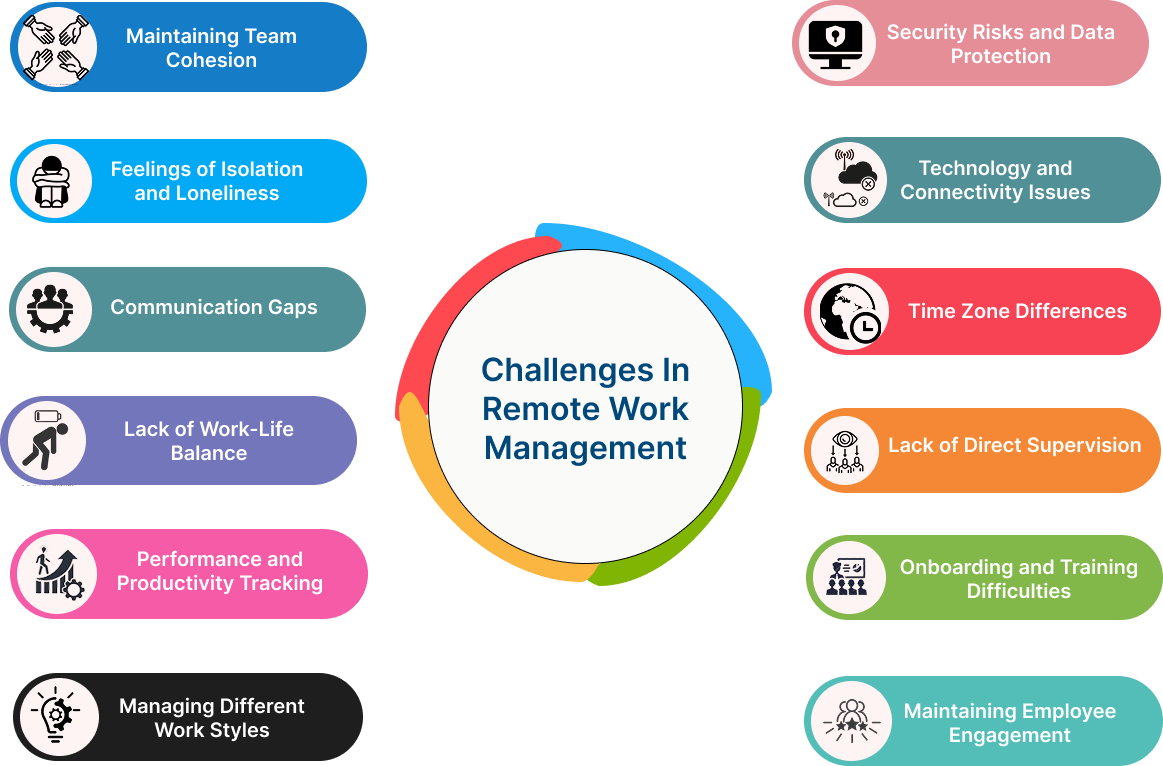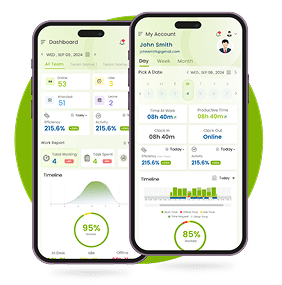The rise of remote work has fundamentally transformed how businesses operate, driven by technological advancements, shifting employee expectations, and global events like the COVID-19 pandemic. This model allows employees to work from virtually anywhere, breaking down geographical barriers and offering flexibility in the work environment.
The benefits of remote work are numerous, including greater work-life balance, reduced commuting time, and access to a broader talent pool, allowing organizations to hire the best individuals regardless of location.
However, remote work comes with its challenges, such as feelings of isolation, difficulty in fostering team cohesion, and managing performance without direct oversight. Effective remote team management becomes even more crucial in a remote setting to ensure productivity, maintain morale, and create a sense of purpose among employees
One tool that can assist in overcoming some of these challenges is remote work time tracking software This guide will explore the best practices and strategies to navigate the remote work landscape successfully, with a focus on building strong teams, fostering communication, and overcoming the hurdles that come with employee remote management.
Challenges In Remote Work Management

Remote work has become increasingly prevalent, offering flexibility and freedom for employees. However, managing remote teams presents its own unique set of challenges. Without the structure of a traditional office environment, managers must find new ways to maintain productivity, ensure communication, and foster a positive work culture.
From tracking performance to overcoming technological barriers, effective remote work management requires innovative approaches to ensure teams remain connected, engaged, and successful. Let’s learn the most common challenges faced during remote work management:

Communication Gaps
Remote work can often lead to fragmented communication. Without face-to-face interaction, it’s easy for important details to be lost or misunderstood. Miscommunications can happen more frequently in emails, messages, or through chat platforms. Non-verbal cues, such as body language and tone of voice, are absent, which can lead to confusion or errors in interpretation.

Feelings of Isolation and Loneliness
One of the most prominent issues remote workers face is feeling disconnected from their teams. The lack of in-person interaction can make employees feel isolated, leading to a sense of detachment from colleagues and the organization. This loneliness can cause emotional distress, decrease job satisfaction, and, in the long term, result in higher turnover rates.

Maintaining Team Cohesion
Building a cohesive and collaborative team becomes more difficult when employees are working remotely. The lack of spontaneous office interactions, such as lunch breaks, hallway conversations, or casual chats, makes it harder for team members to bond. Team cohesion, which is vital for trust, collaboration, and morale, can suffer in a remote environment, leading to reduced collaboration and productivity.

Lack of Work-Life Balance
While remote work offers flexibility, it can also blur the boundaries between personal and professional life. Many remote workers find themselves working longer hours or failing to “switch off” at the end of the day because their workspace is also their home. This imbalance can lead to burnout, stress, and decreased job satisfaction over time.

Performance and Productivity Tracking
One of the key difficulties in remote work management is tracking employee performance and productivity without direct oversight. Managers can’t physically monitor their teams, which can create challenges in ensuring tasks are completed on time or at the expected quality. Performance metrics, such as task completion, work hours, and productivity, are harder to track, leading to potential issues with accountability.

Technology and Connectivity Issues
Remote work heavily relies on technology, which brings its own set of issues. Employees may face problems with unstable internet connections, malfunctioning software, or difficulty accessing company networks. Even though there are plenty of digital workplace tools these technological barriers can cause delays, reduce productivity, and disrupt communication between teams. Additionally, the disparity in employees’ technological setups can create inconsistencies and problems that need to be addressed. To mitigate these challenges, offline tracking offers a valuable solution, allowing employees to track their time and progress even without an active internet connection.

Time Zone Differences
Managing remote teams spread across different time zones complicates scheduling and coordination. It becomes difficult to find overlapping working hours for meetings or real-time discussions. Communication delays can occur, and team members may have to work outside of their most productive hours, leading to frustration or misalignment in work progress

Lack of Direct Supervision
Remote work often removes the direct supervision that is common in a physical office. Managers may struggle to ensure that employees are staying focused, managing their time effectively, and meeting deadlines. Without face-to-face supervision, it can be hard to gauge how employees are working, which could lead to concerns about accountability, work quality, or potential underperformance.

Onboarding and Training Difficulties
Onboarding new employees remotely is more challenging than in a traditional office setting. New hires may feel disconnected from the company culture and struggle with learning their job responsibilities without in-person support. Additionally, training materials that are typically delivered in person or through shadowing colleagues must be adapted to a virtual environment, which may not provide the same level of immersion or understanding.

Maintaining Employee Engagement
Keeping remote employees engaged can be challenging, especially without regular in-person interactions that boost motivation. When working in isolation, it’s harder for managers to foster employee engagement and maintain a sense of connection. Remote workers may feel less motivated or disengaged if they don’t feel like part of the team or if their contributions aren’t adequately recognized.

Security Risks and Data Protection
Security risks increase with remote work, especially when employees use personal devices or networks to access company data. The potential for data breaches, hacking, or loss of sensitive information is heightened when workers are outside the secure office environment. Ensuring secure access to company networks, encrypted communication, and proper data protection protocols becomes increasingly challenging as teams operate from diverse locations. Adhering to GDPR policies is crucial in this context, ensuring that personal data is handled securely and in compliance with privacy regulations across all remote operations.

Managing Different Work Styles
Remote teams often consist of individuals with diverse work styles, backgrounds, and preferences. For example, some employees may be more comfortable with structured schedules, while others prefer flexibility. Additionally, varying time zones, communication styles, and work habits can complicate workflows and collaboration. Aligning these different preferences to create an efficient and cohesive remote work environment can be a significant hurdle for managers. Establishing a clear work schedule that accommodates flexibility such as 4/10, 9/80, or 2-2-3 work styles while ensuring alignment on key tasks and deadlines can help streamline workflows and improve coordination across the team.
Top 10 Strategies For Remote Work Management
Effective remote work management is essential for maintaining employee productivity collaboration, and employee well-being in a virtual environment. With the right strategies, managers can successfully navigate the challenges of remote work and build high-performing teams. The following top 10 strategies provide practical guidance for managing remote teams, ensuring clear communication, fostering a positive culture, and boosting overall performance.
1. Set Clear Expectations and Goals
Clear expectations help avoid confusion and ensure team members understand their responsibilities. In a remote environment, it’s essential that managers define precise goals and measurable outcomes
-
Define roles and responsibilities:
Each team member should know exactly what their job entails, the specific tasks they’re responsible for, and how their work contributes to the overall success of the team and organization. This clarity helps avoid overlap, misunderstandings, and missed deadlines.
- Set measurable objectives:
To maintain alignment, set clear, measurable objectives for each team member, and ensure that these are tied to broader business goals. Regular progress reviews (e.g., weekly or monthly) can be helpful to measure the team’s overall productivity and make necessary adjustments
- Check-ins and progress tracking:
Regular check-ins are essential for managers to monitor progress, identify any potential roadblocks early, and offer timely feedback. With Desklog’s project tracking dashboard, you can easily keep track of progress, pinpoint areas that need attention, and identify the team members who require support. This ensures that everyone stays on track and remains focused on the right goals, while also providing a platform for team members to request assistance when needed.
2. Advanced Technology and Tools
Remote work management heavily depends on technology. Selecting the right tools for remote work management not only enhances productivity but also helps foster better collaboration.
- Time tracking software:
➤Time tracking tools like Desklog are an essential addition to any remote work setup. Desklog allows managers to track time spent on various tasks, ensuring that employees are staying productive and focused throughout the day. This tool helps in tracking work patterns, analyzing productivity trends, and identifying areas where employees may need additional support.
- Collaboration tools:
Communication platforms like Slack or Microsoft Teams allow remote workers to stay in constant contact, ask questions, and maintain a sense of camaraderie. Video conferencing tools such as Zoom and Google Meet help replicate face-to-face meetings, fostering deeper connections and more effective collaboration.
- Project management tools:
Project management tools, like Desklog, are essential for organizing tasks, setting deadlines, assigning responsibilities, and ensuring accountability. Desklog’s subtask feature helps users break down large projects into manageable chunks, accelerating completion. Additionally, it allows managers to track project progress, monitor individual responsibilities, and manage workflow efficiently.
- File-sharing tools:
With team members scattered across various locations, cloud storage services like Google Drive and Dropbox ensure that all team members have access to the most up-to-date documents and files. This helps prevent confusion and ensures that no one is working off outdated information.
➤ Desklog can also be used for project time tracking and reporting, giving managers a clear picture of how time is spent and helping to make data-driven decisions. Time tracking software is crucial for ensuring transparency in performance and for maintaining accountability in remote environments where managers might not have direct oversight.
➤ Desklog offers a complete suite of features to simplify workplace management Leave Management simplifies the leave process with automated requests, approvals, and balance tracking, allowing employees to monitor their leave while providing managers with real-time updates for better workforce planning.
➤ Overtime Alerts & Breaktime Notifications keep employees on track by sending instant alerts when overtime is approaching and reminding them to take regular breaks, ensuring compliance and promoting well-being.
➤ Activity Tracking provides detailed reports on tasks, applications, and websites used, helping to identify productivity issues and maintain efficient workflows, while app & URL tracking offers valuable insights into time spent on productive tasks versus distractions.
➤ Lastly, Shift Management allows managers to easily assign, adjust, and track shifts, reducing scheduling errors and ensuring optimal team performance through automated scheduling.
3. Foster Open and Transparent Communication
Effective communication is the backbone of successful remote teams. Without regular in-person interactions, team members may feel isolated or disconnected.
- Encourage regular updates:
Managers can establish daily or weekly stand-ups (short meetings or check-ins) where team members provide brief updates on their progress. This creates a rhythm for accountability, keeps everyone aligned, and encourages a collaborative environment.
- Promote asynchronous communication:
Because remote teams often span across different time zones, synchronous communication can be difficult. Encouraging asynchronous communication where messages are sent and responded to at different times lets team members respond when it’s convenient for them, making it easier for everyone to collaborate regardless of location.
- Create feedback loops:
Open communication isn’t just about giving updates but also receiving feedback. Managers should make it a priority to solicit feedback from their team regularly, asking about their experiences, challenges, and whether tools and processes are working. This helps identify problems early and adjust strategies quickly.
4. Build a Strong Team Culture
Remote teams can suffer from a lack of connection due to the physical distance between members. Building a strong team culture requires intentional actions.
- Virtual team-building activities:
Virtual team-building exercises like trivia games, online challenges, or virtual “coffee chats” can help create opportunities for casual socializing. These activities allow team members to bond, share experiences, and build trust, ultimately improving team morale.
- Promote inclusivity and diversity:
Remote work has the potential to bring together diverse talent from around the world. Ensuring that all voices are heard, regardless of geographical location, promotes a culture of inclusivity. Leaders should make it a priority to recognize cultural differences and encourage open dialogue on inclusivity.
- Recognize and reward achievements:
Public recognition is a powerful motivator. By regularly celebrating individual and team accomplishments, whether during meetings or in a public forum (like Slack), managers help foster a positive work environment where employees feel valued.
5. Encourage Autonomy and Trust
One of the key benefits of remote work is the flexibility it offers. Trusting employees to manage their time and tasks without constant oversight is essential for fostering an environment of independence and responsibility.
- Avoid micromanagement:
Remote employees tend to prefer a more flexible work environment, and micromanaging can undermine their autonomy and negatively impact morale. Instead, focus on results rather than processes, allowing employees to find their own ways to achieve their objectives. Encouraging autonomy helps preven toxic productivity where employees feel pressured to constantly overwork, leading to burnout and reduced overall performance.
- Empower decision-making:
When employees are given the authority to make decisions within their scope of responsibility, it fosters a sense of ownership. This can lead to greater engagement and higher job satisfaction. Empowering employees also increases productivity as they feel more confident in their abilities.
- Trust and responsibility:
Building trust and demonstrating that you believe in your employees’ capabilities strengthens relationships. Trusting your employees to deliver without constant supervision will also reduce stress and foster a healthier work-life balance.
6. Provide Professional Development Opportunities
Remote employees can sometimes feel disconnected from career advancement. Offering development opportunities is a way to show employees that you care about their future growth.
- Offer online training and workshops:
Remote workers benefit from online training platforms like LinkedIn Learning, Coursera, or even internal resources to build new skills. Continuous learning opportunities keep employees engaged and help them stay competitive in their field.
- Mentorship and coaching:
Regular mentorship can help employees feel more connected to the company and provide them with valuable guidance to grow their skills. Pairing employees with mentors or offering coaching programs also helps build deeper relationships and fosters employee loyalty.
- Career growth conversations:
One-on-one discussions about career goals show that you are invested in your employees’ long-term success. These conversations offer a chance to identify potential career paths and discuss how employees can work towards them within the company.
7. Monitor Well-Being and Prevent Burnout
Adopting remote work can blur the lines between personal and professional life, leading to burnout if not managed effectively.
- Encourage work-life balance:
:Remote workers often face the temptation to work longer hours. To prevent this, managers should encourage employees to set boundaries, take regular breaks, and maintain a healthy work-life balance. Being clear about after-hours communication expectations can also prevent work from spilling over into personal time, helping employees to recharge and stay productive in the long run.
- Support mental health:
Mental well-being is essential for long-term success. Managers should actively encourage employees to discuss their mental health and offer support where needed. Providing access to virtual therapy or counseling services can help employees cope with stress.
- Recognize signs of burnout:
Remote workers may be less likely to express signs of burnout until it’s too late. Managers need to be vigilant for any indicators, such as decreased communication or performance, and address them early by offering support and a change in workload if necessary.
8. Measure Performance, Not Hours Worked
One of the most significant shifts in remote team management is focusing on performance rather than hours worked.
- Set performance metrics:
Set performance metrics: Managers should establish clear, outcome-based performance metrics that focus on achieving specific objectives, such as meeting deadlines or maintaining high-quality standards. These metrics help track employee efficiency by measuring how well tasks are completed within a given time frame, and employee utilization by ensuring resources are effectively allocated to maximize productivity without overburdening employees.
- Provide clear feedback:
Regular performance evaluations allow employees to understand how well they’re doing. These conversations offer the opportunity to celebrate successes, discuss challenges, and set new goals.
- Conduct performance reviews:
Formal performance reviews help assess individual contributions, identify areas for improvement, and plan for future growth. These reviews are essential for maintaining alignment with business goals and recognizing top performers. As part of the performance development plan managers can use these reviews to set clear development goals, provide targeted feedback, and outline strategies for continuous skill enhancement, ensuring long-term success for both employees and the organization.
9. Adapt to Time Zone Differences
Managing time and teams across multiple time zones can present coordination challenges, but it can also offer flexibility.
Establishing a core time frame during which all team members must be available ensures that essential meetings can happen without the need to schedule across inconvenient time zones
Allowing team members to work at different hours based on their location ensures flexibility while maintaining productivity. This approach prevents frustrations and ensures that everyone can work during their most productive hours.
Managers should actively be aware of where each team member is located and adjust meeting times accordingly. Tools like Time Zone Converter can help identify overlapping work hours.
Be Adaptable and Flexible
Remote work can be unpredictable, and managers must remain agile and open to changes.
- Pivot when necessary:
The remote work environment can change quickly, whether due to new technology, unforeseen disruptions, or changes in business needs. Managers must be flexible and ready to adjust their approach as required to maintain productivity.
- Be patient and understanding:
Personal challenges such as childcare, internet issues, or health problems are a reality for remote employees. Being patient and supportive helps maintain trust and morale, ensuring that the team remains motivated and productive.
In Summary,
Remote work has fundamentally reshaped the way businesses operate, offering unprecedented flexibility and access to a global talent pool. However, managing remote teams requires a thoughtful approach to overcome the unique challenges of communication, isolation, performance tracking, and maintaining team cohesion.
By employing the right strategies, such as setting clear expectations, utilizing advanced technology and tools, fostering open communication, building a strong team culture, and providing professional development, managers can create a remote work environment that promotes productivity, engagement, and well-being. Flexibility, trust, and adaptability are key to ensuring the continued success and growth of remote teams in today’s rapidly changing work landscape.
FAQ
1What is remote work management?
Remote work management refers to the process of overseeing a team of employees who work from different locations, typically from home or other remote settings, using technology to ensure productivity, communication, and collaboration.
2How can I overcome communication gaps in remote teams?
To overcome communication gaps, encourage the use of diverse communication tools (e.g., Slack for chat, Zoom for video calls) and establish regular check-ins, both synchronous and asynchronous, to maintain clarity and keep everyone on the same page.
3How do I track performance in a remote work environment?
Performance can be tracked using project management tools like Trello or Asana, time-tracking software such as Desklog, and by setting clear goals and deadlines. Regular progress reviews and feedback loops also help monitor performance effectively.
4What can I do to avoid feelings of isolation among remote workers?
Combat isolation by scheduling regular virtual team-building activities, encouraging social interaction through informal virtual meetings (e.g., coffee chats), and ensuring open communication channels where employees feel connected and supported.
5How do I maintain a strong team culture in a remote setting?
Foster a strong team culture by recognizing achievements, promoting inclusivity and diversity, organizing virtual team-building activities, and regularly communicating company values. Also, ensure employees feel valued and part of a larger purpose.
6How do I manage different time zones in remote teams?
To manage time zones, set core hours during which all team members are expected to be available for meetings, encourage flexible working hours based on time zone differences, and use tools like Time Zone Converter to coordinate schedules efficiently.
7What tools are essential for remote work management?
Remote work management softwares include project management software (Desklog), communication platforms (Slack, Microsoft Teams), video conferencing tools (Zoom), and time-tracking software (Desklog).
8How can I prevent burnout in remote workers?
Prevent burnout by encouraging regular breaks, promoting work-life balance, and setting clear boundaries between work and personal life. Regularly check in on employees’ well-being and provide mental health resources if necessary.
9What are some strategies for onboarding remote employees?
To onboard remote employees effectively, provide complete online training, use virtual shadowing or mentorship programs, and create an online welcome package that includes everything employees need to get started, such as resources and team introductions.
10How can I ensure productivity in remote teams?
Ensuring productivity in remote teams can be done by setting clear goals, using time-tracking tools to monitor time spent on tasks, providing the necessary technology and resources, and maintaining an open line of communication for support and feedback

















